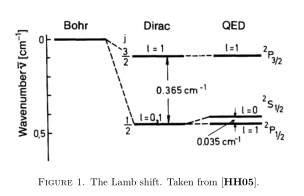There is no doubt that the spectral effect found by Lamb and Retherford was a rise of about 1.0 GHz of the 2S sub 1/2 energy level above the 2P sub 1/2 level. Google "Lamb shift rise of 1 GHz", sites one and two that come up, and many other sites and books. The Lamb shift increases the energy of S states, but leaves the energy of P states unchanged. In the Dirac atom, 2S sub 1/2 and 2P sub 1/2 are degenerate. Also Google "Lamb shift of atomic H" first site that comes up. This contains Bethe’s original paper, "The Electromagnetic Shift of Energy levels" (Physical Review). The article mentions: "Bethe considered the Lamb Retherford discovery of the shift of the 2S state of H upward in energy. The easiest way to understand it is an increase in frequency of the 2S sub 1/2 absorption line with respect to the 2P sub 1/2 absorption line. This now known with great precision. I realize that it is important to understand the experimental result. Bethe in this very first paper introduced renormalization, I do not believe the claim of the standard model to incredible QED precision. We are doing very well in explaining it with m theory.
On Mon, Mar 25, 2019 at 3:33 PM Horst Eckardt <mail> wrote:
PS: To be precise, this diagram means that the absolute value of 2S1/2 is DECREASED:
This means that the correction integral of hbar omega must be smaller than one.
Horst
Am 25.03.2019 um 16:10 schrieb Horst Eckardt:
Does the absolute value of the 2S energy increase or decrease?
HorstAm 25.03.2019 um 16:06 schrieb Myron Evans:
Calculation of Lamb shift
The frequency of the 2S state increases to about a gigahertz above the 2P state (Wiki, Lamb shift entry). So the energy of the 2S state increases with respect to that of the 2P state. The energy is h bar omega multiplied by a correction value integral psi* (1 / m(r) half psi dtau, so the correction value must increase, i..e become greater than 1.
Calculation of Lamb shift: sign problem
To make it clear: If the energy level of 2S becomes less negative valued, the absolute value decreases. Therefore the correction factor of the 2S state becomes smaller than one. Do you agree to this argument?
Horst
Am 25.03.2019 um 15:11 schrieb Myron Evans:
Calculation of Lamb shift: sign problem
OK thanks, I would suggest experimenting to find the m(r) function that gives the experimental result. As long as m(r) becomes one in the Minkowski space, there is freedom of choice, so it can become greater than one. It is encouraging that an exponential m(r) gives the correct result of S being shifted and P not being shifted. There is a rise of about 1000 MHz of the 2S level. This means that the energy level of 2S becomes less negative valued, and the frequency increases. The absolute value of energy increases, so the absolute value of the theoretical result would match the experimental result.
Calculation of Lamb shift: sign problem
Accoring to the diagram of Fig. 1 in UFT429, the Lamb shift affects the
2S1/2 state, not the 2P1/2 state. This is verified by our exponential
m(r) functions. However the absolute value of the energy level shrinks
(because the levels in the diagram are negative). This is in conflict
with the expectation valueintegral psi* 1/m(r)^(1/2) psi dtau
which gives values >1 because m(r)<1 near to the centre. The situation
could be remedied by using a m(r)>1, but this would change all our
assumptions we made before.
I appended the diagram with relative energy change of the 2S1/2 state.
The experimental shift has been added. The parameter R is about 0.015
Bohr radii which is about twice the value obtained form s-o coupling in
UFT 429.Horst
